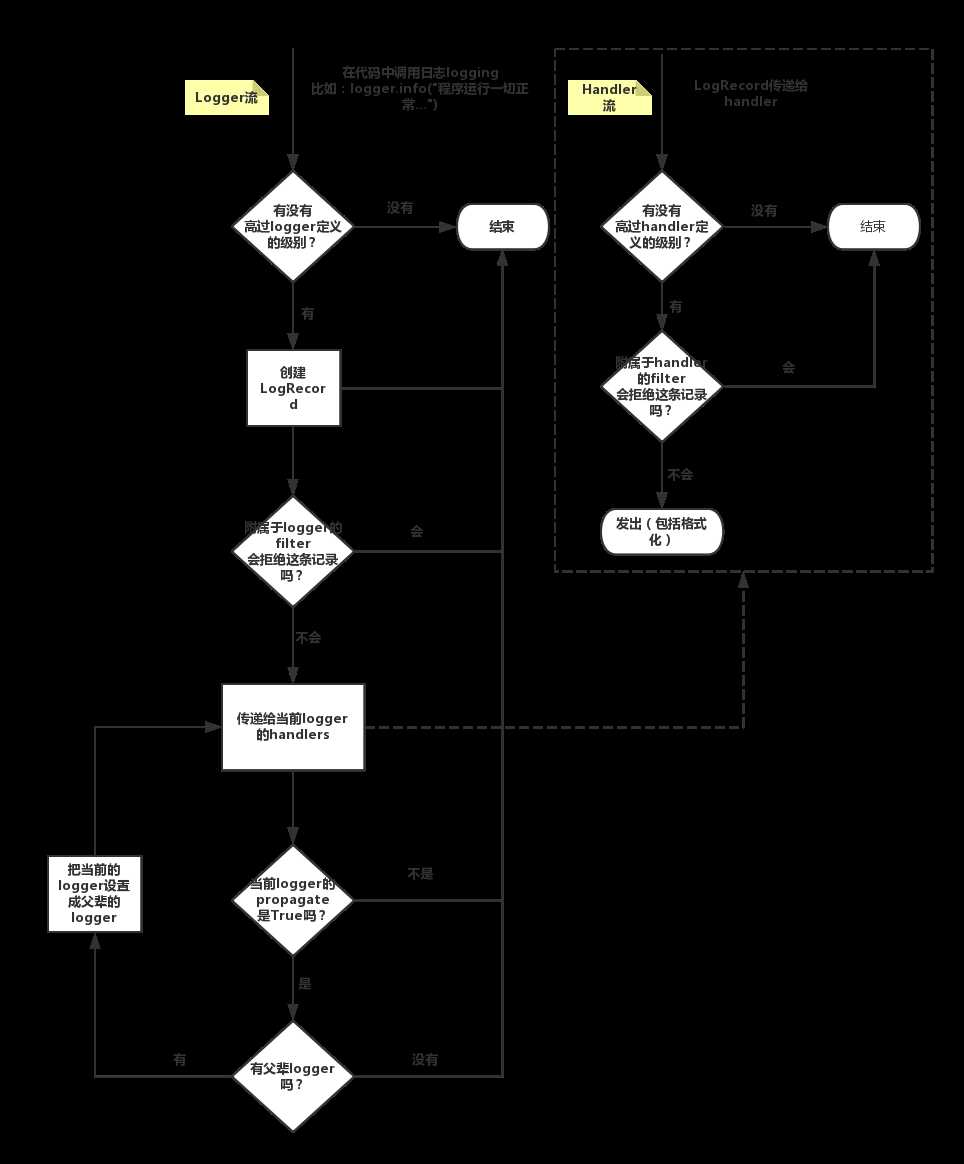标签:匹配 width 项目 存在 collect nbsp 实例 odi 创建
做开发离不开日志,以下是我在工作中写Django项目常用的logging配置。
# 日志配置
BASE_LOG_DIR = os.path.join(BASE_DIR, "log")#根目录,在项目里面创建一个目录放日志
# django提供的一个配置项
LOGGING = {
‘version‘: 1, # 保留字
‘disable_existing_loggers‘: False, # 是否禁用已经存在的日志实例
‘formatters‘: { # 定义日志的格式
‘standard‘: {
‘format‘: ‘[%(asctime)s][%(threadName)s:%(thread)d][task_id:%(name)s][%(filename)s:%(lineno)d]‘
‘[%(levelname)s][%(message)s]‘
},
‘simple‘: {
‘format‘: ‘[%(levelname)s][%(asctime)s][%(filename)s:%(lineno)d]%(message)s‘
},
‘collect‘: {
‘format‘: ‘%(message)s‘
}
},
‘filters‘: { # 定义日志的过滤器
‘require_debug_true‘: {
‘()‘: ‘django.utils.log.RequireDebugTrue‘,
},
},
‘handlers‘: { # 日志处理程序
‘console‘: {
‘level‘: ‘DEBUG‘,
‘filters‘: [‘require_debug_true‘], # 只有在Django debug为True时才在屏幕打印日志
‘class‘: ‘logging.StreamHandler‘,
‘formatter‘: ‘simple‘
},
‘SF‘: {
‘level‘: ‘INFO‘,
‘class‘: ‘logging.handlers.RotatingFileHandler‘, # 保存到文件,根据文件大小自动切
‘filename‘: os.path.join(BASE_LOG_DIR, "xxx_info.log"), # 日志文件
‘maxBytes‘: 1024 * 1024 * 500, # 日志大小 50M(最好不要超过1G)
‘backupCount‘: 3, # 备份数为3 xx.log --> xx.log.1 --> xx.log.2 --> xx.log.3
‘formatter‘: ‘standard‘,
‘encoding‘: ‘utf-8‘, # 文件记录的编码格式
},
‘TF‘: {
‘level‘: ‘INFO‘,
‘class‘: ‘logging.handlers.TimedRotatingFileHandler‘, # 保存到文件,根据时间自动切
‘filename‘: os.path.join(BASE_LOG_DIR, "xxx_info.log"), # 日志文件
‘backupCount‘: 3, # 备份数为3 xx.log --> xx.log.2018-08-23_00-00-00 --> xx.log.2018-08-24_00-00-00 --> ...
‘when‘: ‘D‘, # 每天一切, 可选值有S/秒 M/分 H/小时 D/天 W0-W6/周(0=周一) midnight/如果没指定时间就默认在午夜
‘formatter‘: ‘standard‘,
‘encoding‘: ‘utf-8‘,
},
‘error‘: {
‘level‘: ‘ERROR‘,
‘class‘: ‘logging.handlers.RotatingFileHandler‘, # 保存到文件,自动切
‘filename‘: os.path.join(BASE_LOG_DIR, "xxx_err.log"), # 日志文件
‘maxBytes‘: 1024 * 1024 * 5, # 日志大小 50M
‘backupCount‘: 5,
‘formatter‘: ‘standard‘,
‘encoding‘: ‘utf-8‘,
},
‘collect‘: {
‘level‘: ‘INFO‘,
‘class‘: ‘logging.handlers.RotatingFileHandler‘, # 保存到文件,自动切
‘filename‘: os.path.join(BASE_LOG_DIR, "xxx_collect.log"),
‘maxBytes‘: 1024 * 1024 * 50, # 日志大小 50M
‘backupCount‘: 5,
‘formatter‘: ‘collect‘,
‘encoding‘: "utf-8"
}
},
‘loggers‘: { # 日志实例
‘‘: { # 默认的logger应用如下配置
‘‘‘
SF 文件 console终端 报错error
‘‘‘
‘handlers‘: [‘SF‘, ‘console‘, ‘error‘], # 上线之后可以把‘console‘移除
‘level‘: ‘DEBUG‘,
‘propagate‘: True, # 是否向上一级logger实例传递日志信息
},
‘collect‘: { # 名为 ‘collect‘ 的logger还单独处理
‘handlers‘: [‘console‘, ‘collect‘],
‘level‘: ‘INFO‘,
}
},
}
应用
# 导入 import logging # 实例化log对象 -->logger # llogger = logging.getLogger(‘这个名字要和配置的名字匹配,在loggers里可以指定用什么处理‘) logger = logging.getLogger(‘__name__‘)#以当前文件的名字创建实例 # 使用 logger.error(str(‘返回什么错误‘))
# logging.debug() == print()看错
附:Python logger流示图

标签:匹配 width 项目 存在 collect nbsp 实例 odi 创建
原文地址:https://www.cnblogs.com/xihuanniya/p/10295991.html